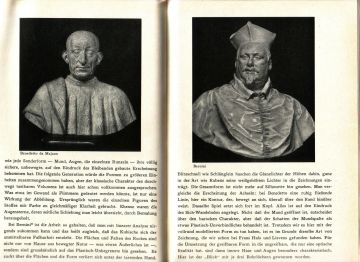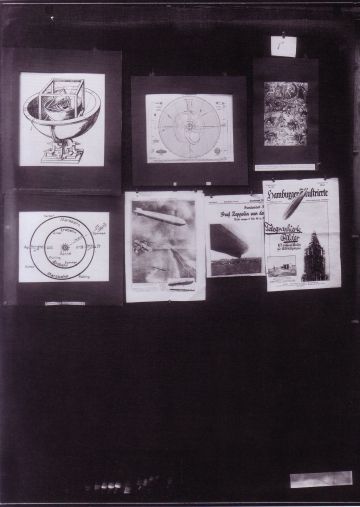Abstract
Images as Memory Banks: Warburg, Wölfflin, Schwitters, and Sebald
Kurt W. Forster
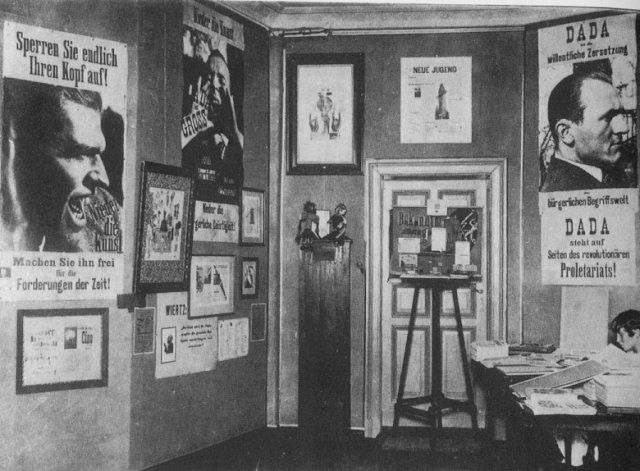
1. G. Grosz, DADA installation Gott mit uns, 1921 (destroyed)
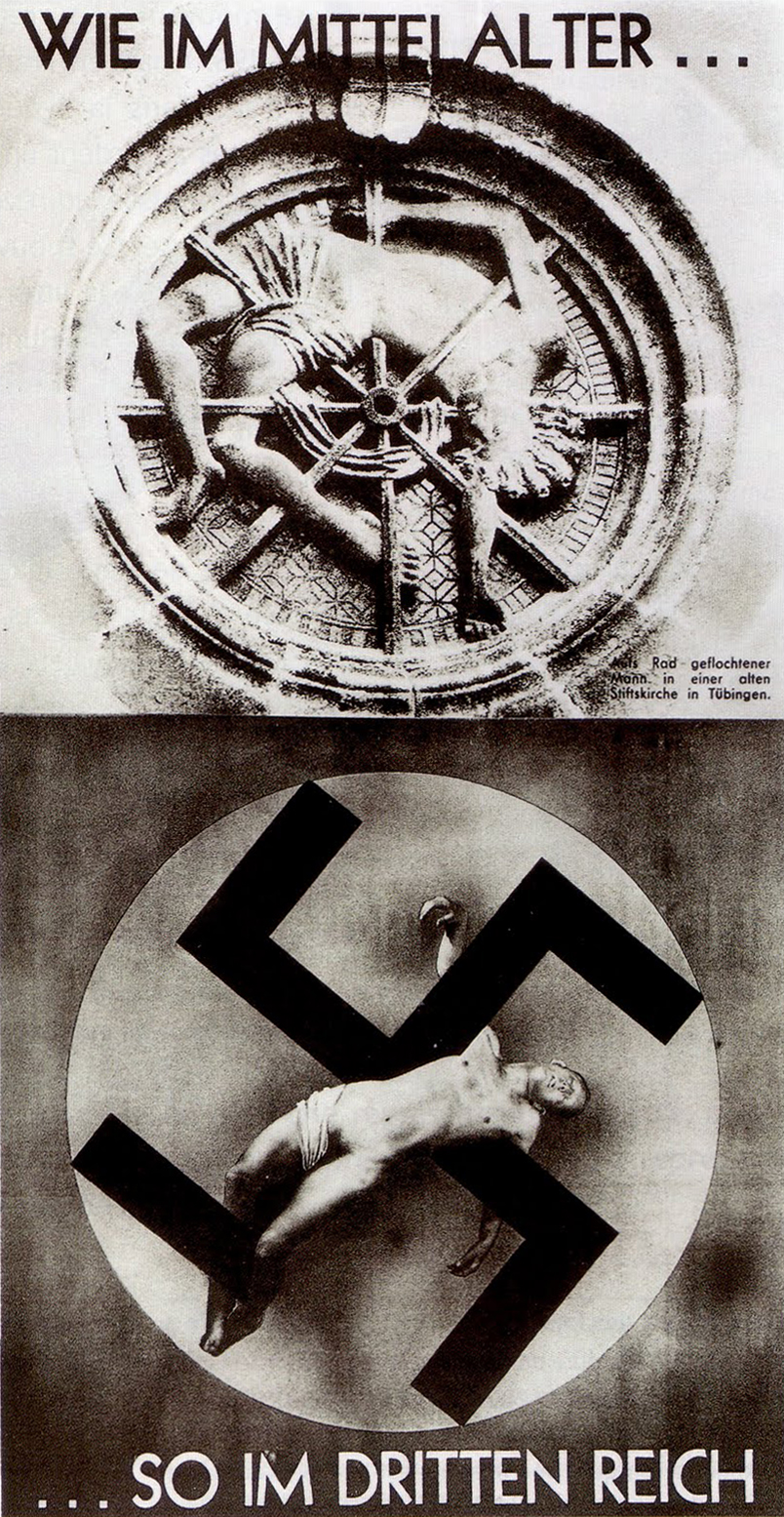
1a - J. Heartfield, Wie im Mittelalter... so im Dritten Reich, photocollage, 1934
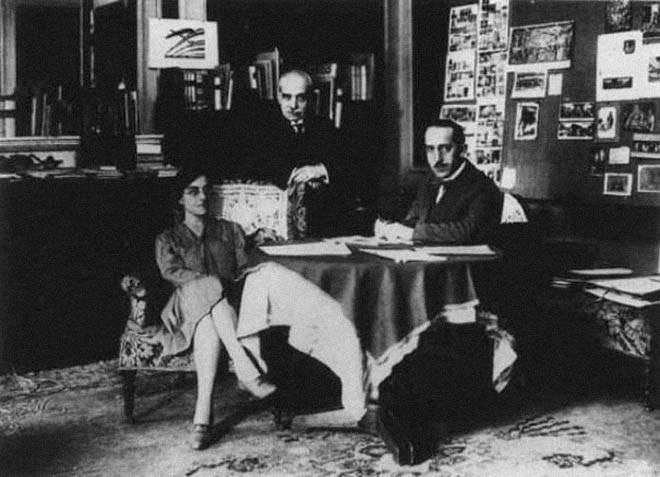
2. A. Warburg (with G. Bing and F. Alber) in his Roman Hotel suite, 1929
Among producers and interpreters of images, a curious change of role has occurred in the course of the 20th century: While it was customary for amateurs to assemble documents and objects that interest them passionately, it was taken for granted that artists would produce "fresh" work and not worry too much about the dregs that accumulate in their making.
A change in the attitude of artists and amateurs (let us call them such) toward images can be traced to the time of WWI, when the world was truly shattered and many things, vast landscapes, entire towns and nations fell into ruin. Artists began to pick up what had fallen to pieces, plucking shards and fragments from the heaps of debris, mounting them on their canvases and gluing them into their collages. Dadaist experiments and the collages of Kurt Schwitters (1887–1948), which, in the 1920s, he ultimately expanded from scraps to entire interiors, such as the MERZ-Bau in his Hanover apartment, raised the impromptu approach of bricolage to the level of a productive strategy. That Schwitters had originally nicknamed his MERZ-Bau the Cathedral of Erotic Misery endows his habitable montage with an emotional power drawing in equal parts on frustration and elation (Elger 1999). Its enveloping nature accomplishes the old trick of allowing the viewer to "enter" an image in order to experience its power rather than remaining forever at its threshold. In this respect, the MERZ-Bau can rightly be considered a collage extended to the third dimension.
In the act of its making, collage also creates the site where things can be pieced together and turned into new arrangements. Working strictly with photographs rather than with the dregs of the atelier – such as the labels, cigarette packages, wallpaper or news clippings Picasso and Braque had famously mounted on their drawings and paintings well before the War – German artists George Grosz and John Heartfield claimed to have invented or discovered photo-collage. Theirs was a peculiar operation, bending photography toward synthetic and composite images, rather than only combining disjointed bits and pieces in a manner that drew strength precisely from the accidents of studio "sweepings" [déchet d’atelier]. Since every original act must have a place and time when it first occurred in order to enter the pantheon of art, George Grosz chronicled his joint operation on a May day in 1916 at five in the morning, in the midst of the War: “When Johnny Heartfield and I invented photo-montage in my studio at the south end of town…, we had no idea of the immense possibilities, or the thorny but successful career that awaited the new invention” (cit. in Richter 1965, p. 117). As typically happens, they just stumbled upon a gold mine without realizing it. While such lightning discoveries make attribution mandatory, it is not at all clear whether that hour of dawn has a right to be consecrated as the birth of photo-collage. There can be little doubt, however, that its transformative power changed the postwar practices of Dadaists and Surrealists and lastingly affected the status of photographic images. Early on, the technology of graphic reproduction had allowed for overprinting and for insertions, not unlike the way age-old printing from woodblocks enabled substitution and repair, but also deliberate falsification. Combined with the tricks of the photo retoucheur, the technique of collage opened up a wide range of transformations that ultimately flow together in the era of pixel-based images that are nothing if not matrices of manipulation.
What, you might wonder, has this got to do with Warburg? As much, or more, as the use of photographs (and other reproductive techniques) by Heinrich Wölfflin has to do with the arguments advanced in his books since the late 19th century. Publications such as Renaissance und Barock (1888) and his lectures were based on binary comparisons. By the time Wölfflin made an attempt to construct a "system" of formal analysis, as he did with his Kunstgeschichtliche Grundbegriffe (1915), the binary structure was not just an effective way of illustrating works of art on the book page, but a "principle" for viewing all images in an attempt to group them by the criteria Wölfflin had spelled out in his treatise. Whether he employed parallel projectors in the lecture hall in order to articulate visual comparisons – a practice that influenced the teaching of art history across a whole century – or predicated his arguments on supposedly innate properties of human perception, Wölfflin always sought to embed his results in the cultural history of art. That is why the binary structure of his arguments applies to stylistic periods (Renaissance und Barock) as well as the macro-issues of cultural geography (Die Kunst der Renaissance: Italien und das deutsche Formgefühl, 1931), or the formal properties that he wished to establish for the perception of images.
3. Wölfflin, Renaissance und Barock, 1888
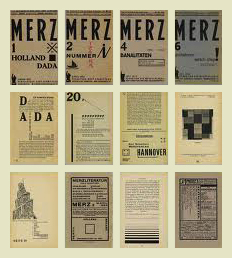
4. MERZ journal, edited by K. Schwitters, 1923-24
In the process of following Wölfflin’s arguments, it turns out that he, too, attributed to images a power larger than any single one of them possesses in and of itself. It appears that he principally wished to wed them in a relationship that balances their differences. The First World War put the relationship between art and life to a test that Wölfflin and Warburg each resolved in his own way. As Martin Warnke has pointed out over two decades ago, both scholars were deeply troubled by the hostilities, to the point that Wölfflin struggled to maintain a proper demeanor while speaking about the influence of Italian art on German art, “as millions of Italian soldiers advance on our borders with bajonnets planted on their rifles” (Warnke 1991, p. 82f). At the same time, Warburg reacted to the increasingly desperate war effort by means of a phantomatic campaign to document it, drawing on various newspapers and drafting his entire family into a feverish operation of press analysis. Warnke recognized an affinity between Wölfflin and Warburg in their hopes for mediation and reconciliation, but he also saw that they profoundly differed in their view of life and art: “Warburg wishes to chronicle and reconstruct the chaos of life, in order to secure knowledge of the distancing, coolly resplendent artistic form. By contrast, Wölfflin abandons life beyond art to its chaotic and diffuse nature” (Warnke 1991, p. 83).
There is more to Wölfflin’s procedure than method; clearly, the binary order at its basis leads to ideas that seem to issue from the images rather than from the historian’s interpretative intent. Or, put another way, the historian is merely the arrangeur creating a disposition that helps instantiate the latent power of images. Wölfflin imposes a conspicuous restraint on his verbal expression. Whatever sparks he generates appear to spring from the tensions inherent in the confrontation of images. As a result, we believe that the pictures deliver the message, not the messenger. In this respect Wölfflin relies on the same intuitive capacity as Warburg did, and yet the nature of their insights could not differ more strongly from one another. Whereas Wölfflin seeks Ausgleich or objective difference, difference as categorical and undialectical as light and dark, linear and painterly, closed and open, Warburg senses the power of “energetic inversion,” of conflict and struggle. Images do possess power and the historian must be able to sense it. Sometimes this power remains latent, barely perceptible, at other times it suddenly releases itself (for a discussion of unintentional connections between Warburg’s photo panels and contemporary artistic practice, see Forster 1995). Such discharges seem to derive strength from a swarm of images that interrelate with one another in multiple ways, as if batteries were rigged together to potentiate the current.
5. A. Warburg, Mnemosyne Atlas, plate C, 1929
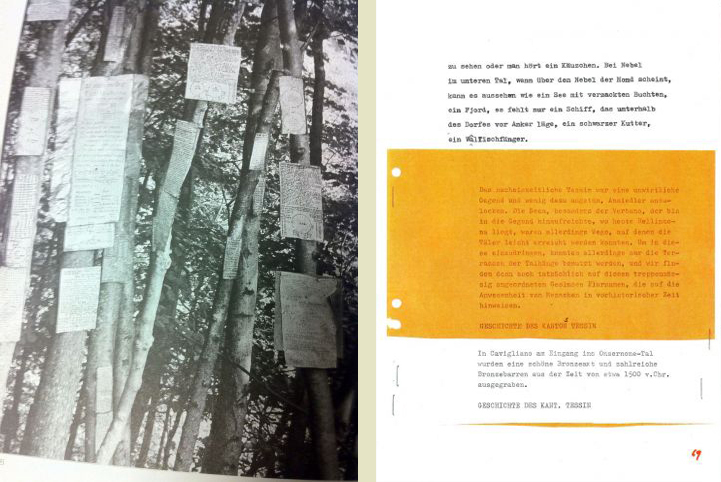
6. Armand Schulthess, “Enzyklopädie im Wald,” Encyclopedic tables appended to the trees on his property in Auressio (Ticino), 1972 (destroyed)
7. Max Frisch, Montage of manuscript page, assembled from different versions (p. 69) in the penultimate version of the novel Der Mensch erscheint im Holozän, late 1970s
To gauge this "electrifying" property of images, one must turn to the German-English author W.G. Sebald (1944–2001) and the almost unprecedented use he made of images in his novels. To a disarming degree, Sebald’s procedure recalls the age-old practice of assembling tokens and memorabilia, photographs, clippings and ephemera in scrapbooks as a ritual of mourning. These scrapbooks do not look to the future for other purposes than to capture reflections of what has happened in the past. Physical repositories that they are, they double as a site of memory and a stimulant for recollection. Few writers of recent years have tapped the intangible nature of relics more perceptively than Sebald, who, by acts of imaginative transfer, managed to turn image tokens into totems of memory. In such writings as The Emigrants (1992) and Austerlitz (2001), he appropriated images from sundry sources to galvanize the reader/viewer into seeing things that are not (or are no longer) there, as if the powers of the writer extended beyond the words and touched the remains of a world that cannot be entered or changed. Precariously positioning himself at a borderline, Sebald seems to waver between securing documentary evidence and capturing the past in the fictional web of his narrative. The (chiefly) photographic images he includes in his texts are oddly reticent participants in his stories, because images differ from words, and because they can weave a spell of their own in the mind. However diminutive in size or blurry in contour, photographic images are able to endow a person appearing in them with a ghostly presence. Sebald recognized this doubling effect and made his own fictional "double" Austerlitz observe that it appears “as if images too had a memory and remembered us” (Sebald 2001, p. 262). Speaking for himself, Sebald repeatedly expressed the feeling that “images exercise a kind of suction on the beholder, that they cannily seduce the viewer to leave the realm of reality and follow their call into an irrational world." He confessed his weakness for photographs and photo albums to a reporter, stating that "the figures in these black and white or sepia pictures have something of lost souls or spectres about them, they are revenants, craving our attention... Writing about them is an attempt to respond to their grievances." (Sebald 1997) Sebald recognized that images do have a life of their own (however spectral it may be) and that they make demands upon their viewers. Images with such capacity of absorption turn into mirror images: whoever plumbs them also fathoms themselves.
Leafing through the pages of Sebald’s books, we begin to recognize that the images appearing here and there in the text have not arrived by way of illustration. It is necessary to delve into Sebald’s personal archive (now in the Deutsches Literaturarchiv in Marbach near Stuttgart) for some insight into the writer’s imagination and his methodical construction of texts. His stories may at times strike the reader as the near-silent musings of a vulnerable mind, at others as vertiginous houses of cards assembled from incomplete decks and by the sheer will of poesis (Forster 2008).
In this regard, Sebald’s work would be difficult to imagine without thinkers like Walter Benjamin and writers like Vladimir Nabokov and Max Frisch. He certainly acknowledged the importance of Benjamin and Nabokov, but his assembly of images and documents (such as graphs from encyclopedias and the like) also owes a debt to Frisch’s Der Mensch erscheint im Holozän of 1979. The genesis of this short story was rather tortuous. It went through several iterations in the 1970s and reached its final version as a result of repeated acts of dismemberment, collage, and rewriting, all in an effort to narrate an aging loner’s struggle with memory in the face of nearly diluvial rains that flood a remote valley in the Ticino. The manuscript versions among Frisch’s papers make clear that "writing" this novel amounted chiefly to "collaging" texts and incidental materials in order to arrive at a highly charged assemblage that continues to engender its own multiple ramifications (Max Frisch-Archiv, Federal Institute of Technology (ETH), Zurich, documents pertaining to Der Mensch erscheint im Holozän). It is no coincidence, then, that Frisch’s protagonist, Herr Geiser, gets caught up in a futile effort of assembling bits and pieces from an encyclopedia, from newspapers and from his own jottings, in a manner that is both distracted (and hence leading to ever more incidental connections) and manic (hence engendering an never-ending series of more notes and reminders). In this respect, Frisch had in mind the obsessive activities of one of his Ticino neighbors when he labored on his novel. Armand Schulthess (1901-1972) was a hermit, a retired career bureaucrat who had spent his days creating a "forest of knowledge." In an attempt as futile as it seemed indispensable to him, he sought to fix on metal plaques and pieces of cardboard an encyclopedic array of information, to which, incidentally, the knowledge of woman, i.e., libido, held the key. A slim publication documenting this truly madcap universe – a one-man Atlas of Human Knowledge – has survived, but Armand’s heirs hastened to dismantle and destroy most everything after his death in 1972 (Schulthess 1996; Schlumpf 2011). It would be fair to say that Frisch’s novel only took off after the fragile web of Armand’s homespun Atlas had been rudely destroyed.
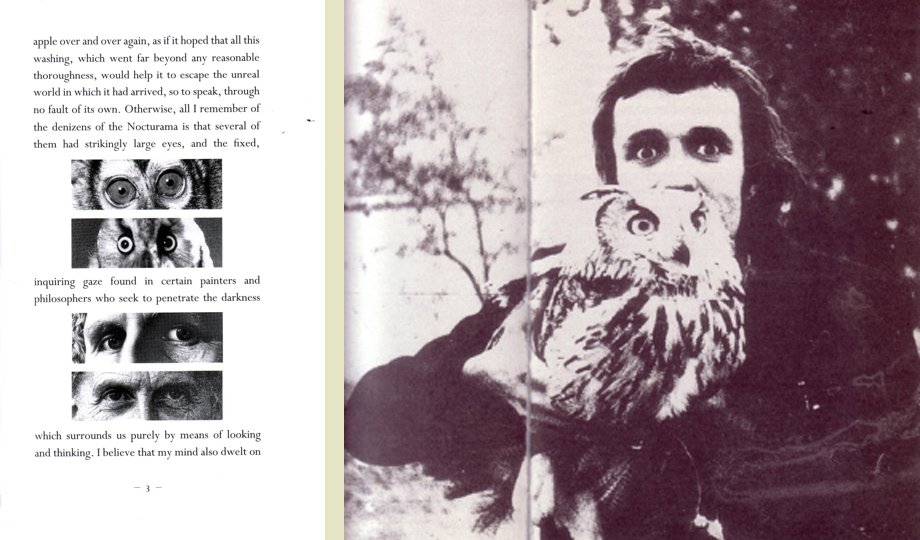
8. W.G. Sebald, page 3: the gazes of humans and owls, from his novel Austerlitz (2001)
9. A. Boetti with his owl in the backyard of his house in Kabul (Afghanistan), early 1979
I’m not suggesting that the lone ravings of a recluse, their transference into Max Frisch’s novel, and the gradual return of the primitive practice of mental bricolage to advanced analytic and imaginative reflections on the part of Warburg and Sebald are one and the same thing. What I do argue is that their incantatory quality draws on the same vein of ritual practice that so fascinated Warburg during his encounter with Native American Indians in Arizona. Warburg, Sebald, and others sought access to a world of prehistoric practices through the enactment of rituals and the analysis of images that keep primal fears and wishes at bay. In all of these efforts, Warburg recognized the particular quality of such knowledge – always indirect and fragile – with great lucidity in the final paragraphs of his Kreuzlingen lecture on the Serpent Ritual: "today, the forces of nature... are no longer recognizable in the anthropomorphic or biomorphic guise [they possessed for the American Indians], but as infinite waves, that respond to the pressure of the human hand" (Warburg [1923] 1988, p. 59).
Such insights also came to haunt Sebald in his efforts to reconfigure lives that would not vanish after he had concluded his novels. The fact that real persons came forward and claimed a share in the times and events Sebald narrated may be less a consequence of his legerdemain with facts than the result of powers that reside in images and names themselves. Pondering this "second life of images," he mused in a radio interview with the Southwest-German Radio that images not only speak to us, but offer those who appear in them an occasion to air their grievances with the present. One of the most compelling instances of such a transfer leaps from a page in Austerlitz, on which Sebald paired eyes of owls and human beings that instantly brings to mind the joint gazes in a photograph of Alighiero Boetti with his owl in Kabul. Less the bird of wisdom than of nocturnal thievery, its gaze is hypnotic and yet wide-awake, a state shared by Warburg at key moments in his quest for the “energetic charges” in images of suffering and of action.
Acknowledgements
I’m grateful to Prof. Dr. Ulrich Raulff, director of Deutsches Literaturarchiv, Marbach, and to members of the archive’s staff for making the entire Sebald Archive material available to me for study in anticipation of the exhibition at the DLA in 2008. I also had the privilege of giving a keynote lecture on the occasion of its inauguration, addressing the “migration of images” in and out of Sebald’s work. I’m indebted to Dr. Ellen Strittmatter of DLA who brought Sebald's interview to my attention (Sebald Archive, Verschiedenes. Reden und Interviews 33.1).
I’m grateful to the Max Frisch-Archiv, Federal Institute of Technology (ETH), Zurich, for granting me access, and particularly to Archivist Dr. Margrit Unser, for providing background information and source material for the gestation of Frisch’s novel.
References
- Elger 1999
Dietmar Elger, Der Merzbau von Kurt Schwitters. Eine Werkmonographie (Köln: König, 1999) - Forster 1995
Kurt W. Forster, “Warburgs Versunkenheit”, in Aby M. Warburg: “Ekstatische Nymphe … trauernder Flußgott”. Portrait eines Gelehrten, eds. Robert Galitz and Brita Reimers (Hamburg: Doelling and Galitz, 1995), pp. 184-206 - Foster 2008
Kurt W. Forster, “Bilder geistern durch Sebalds Erzählungen, Geister bewohnen ihre Zeilen”, in Wandernde Schatten. W. G. Sebalds Unterwelt, eds. Heike Gfrereis and Ellen Strittmatter (Marbach: Deutsches Literaturarchiv, 2008), pp. 87-99 - Richter 1965
Hans Richter, Dada: Art and Anti-Art (London: Thames & Hudson, 1965) - Schlumpf 2011
Hans Ulrich Schlumpf, Armand Schulthess. Rekonstruktion eines Universums (Zurich: Patrick Frey, 2011) - Schulthess 1996
Die Enzyklopädie von Armand Schulthess, ed. Markus Britschgi (Lucerne: Diopter, 1996) - Sebald 1997
Deutsches Literaturarchiv (DLA), Marbach, Sebald Nachlass, Verschiedenes. Reden und Interviews 33.1 (transcript of a radio interview with the Südwestfunk, 14 November 1997) - Sebald 2001
W.G. Sebald, Austerlitz (New York: Random House, 2001) - Warburg [1923] 1988
Aby M. Warburg, Schlangenritual Ein Reisebericht, ed. Ulrich Raulff (Berlin: Wagenbach, 1988) - Warnke 1991
Martin Warnke, “Warburg und Wölfflin”, in Aby Warburg, Akten des internationalen Symposions, Hamburg 1990 (Weinheim: Acta Humaniora, 1991), pp. 79-86
Abstract
Possiamo rintracciare nell’epoca del primo conflitto mondiale un profondo cambiamento nell’approccio alle immagini di artisti e intellettuali. Il mondo fu profondamente scosso dalla guerra: molte cose, accanto a vasti territori e intere città, erano cadute in rovina. Gli artisti iniziarono a raccogliere ciò che era andato in pezzi, scegliendo frammenti dai cumuli di macerie e riassemblandoli sulle loro tele o nei loro collage. Gli esperimenti dadaisti e i collage di Kurt Schwitters (1887-1948) innalzarono l’approccio estemporaneo del bricolage al livello di una strategia produttiva. Gli artisti tedeschi George Grosz e John Heartfield, con l’invenzione del foto-collage, modificarono ulteriormente la prassi artistica del primo dopoguerra, con un durevole effetto sul potere e sullo stato delle immagini fotografiche. Sin dalla fine del XIX secolo, d’altra parte, anche l’accostamento di immagini utilizzato da Heinrich Wölfflin aveva influenzato gli studi storico-artistici nella direzione di stabilire un nesso tra proprietà formali, percezione delle immagini e storia della cultura. La prima guerra mondiale mise alla prova la connessione tra arte e vita che sia Wölfflin sia Aby Warburg, con la creazione dell’Atlante Mnemosyne, avevano tentato di risolvere ciascuno a proprio modo. Il metodo di Wölfflin si basava sulla finezza d’intuito allo stesso modo di quello di Warburg, eppure la natura del loro approccio alle immagini non poteva essere più diversa: mentre Wölfflin cercava differenze oggettive, categoriche e a-dialettiche, Warburg percepiva il potere della “inversione energetica”, del conflitto e dell’attrito tra le immagini. Perché le immagini possiedono effettivamente un potere, una carica ‘elettrica’, e lo storico deve essere in grado di percepirlo. Per misurare l’‘elettricità’ delle immagini è opportuno volgersi all’autore anglo-tedesco Winfried Georg Sebald (1944–2001) e all’uso pressoché inedito delle immagini nei suoi romanzi. La procedura dello scrittore richiama la pratica di assemblare in scrapbooks fotografie, souvenir, ritagli, quasi fosse un rito funebre. Concreti ricettacoli di oggetti, questi scrapbooks si sdoppiano come totem della memoria. Sebald riconosce che le immagini hanno una vita loro propria – per quanto spettrale – e che avanzano delle richieste agli osservatori. Immagini con una simile capacità di assorbimento divengono immagini-specchio: chiunque ne misuri la profondità, sonda anche se stesso. L’opera di Sebald non sarebbe immaginabile senza scrittori come Benjamin, Nabokov o Frisch. In particolare L’uomo nell’Olocene di Frisch (1979), ispirato alla peculiare ‘Enciclopedia nel bosco’ di Armand Schulthess, consiste di un collage di testi e materiali fortuiti che giunge a un assemblaggio ‘ad alta tensione’, ancora in grado di fornire molteplici ramificazioni. La qualità ipnotica delle immagini nell’opera di Sebald e di Frisch, e prima di Warburg, attinge allo stesso sostrato della pratica rituale che tanto affascinò Warburg nel suo incontro con gli Indiani dell’Arizona. Warburg, Sebald e altri hanno cercato di accedere a un mondo preistorico mediante l’attuazione di prassi rituali e mediante l’analisi di immagini capaci di tenere sotto controllo desideri e paure primevi.
keywords | Images; Memory; Warburg; Wölfflin; Schwitters; Sebald; Collage; Photography.
Per citare questo articolo / To cite this article: K. W. Forster, Images as Memory Banks: Warburg, Wöfflin, Schwitters, and Sebald, “La Rivista di Engramma” n. 100, settembre-ottobre 2012, pp. 113-120 | PDF
